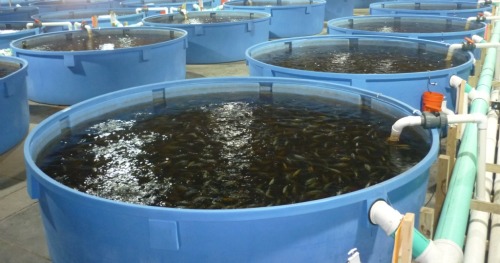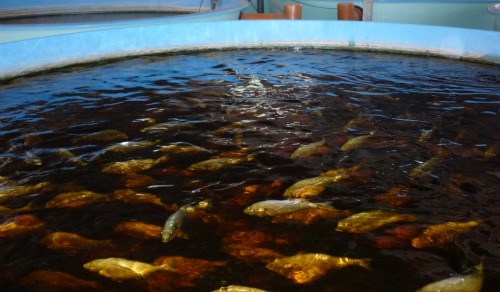
“There’s plenty of fish in the sea,” the old saying goes – but that’s not as true as it once was. In fact, says Dotan Bar-Noy, CEO of Israel’s GFA (Grow Fish Anywhere) Advanced Systems, there are fewer fish in the sea with each passing year. “Overfishing is a much bigger problem than people realize, and in a few years, many species of salt water fish are simply going to disappear if something isn’t done.”
Bar-Noy and 30 or so others – mostly engineers, marine biologists and other technical folk – have found a solution to the diminishing numbers of fish in the sea. Based on the work of Israeli scientist Dr. Yossi Tal and Hebrew University professor Jaap van Rijn – inventor of the system – GFA has developed an on-land environment where fish can be raised, without having to exchange water or treat it chemically.
“We call this a zero-discharge system,” Bar-Noy tells ISRAEL21c. “We use biological filters and specially developed bacteria to treat the water the fish are growing in, without wasting anything. The system can be set up to raise salt-water fish anywhere in the world – even in the desert, thousands of miles from the ocean,” he asserts.
Fish farms are nothing new. They’ve been around for years, enabling growers to set up controlled environments that can ensure a specific yield of fish, allowing them to guarantee delivery without worrying about dwindling supplies in the ocean, pollution, inclement weather, and other factors that are hard to control.
Fish farm foibles
Still, while they enhance the conservation of fish in the sea, fish farms have problems of their own – mostly due to the need to circulate the water in the pools and tanks where the fish are raised. Most fish farms are located adjacent to a body of water, and their waste-laden water is channeled into the sea, and replaced with “fresh” sea water.
While fish raised in captivity don’t produce an increased amount of waste, at sea it would be dissipated over a much wider area. The fish waste, with its nitrogen and other elements concentrated in a relatively small area, renders the water that it’s dumped into uninhabitable for fish.
As the tanks are generally located near the shore, in relatively shallow water, the wastewater tends to linger there. With the movement of the currents, nearby jurisdictions are liable to find a considerable number of fish floating belly-up in their bays and harbors, having been poisoned by the high concentration of nitrogen and nutrients in the wastewater dumped from the tanks.

This problem is so serious that in some areas fish farms are banned, despite their being perhaps the only technologically feasible solution available to combat overfishing, says Bar-Noy. Alternative purification systems are based on electrical treatment systems which are expensive to install and run, and are not all that effective, he notes. “Even when they work, the electrical purification systems are too expensive, and fish produced with those systems will cost far more than fish from the sea.”
GFA is currently the only solution that eliminates the environmental problems associated with fish farming. Tanks are filled with water, then with fish – and added to the mix are microbes perfected by GFA to treat the nitrogen and organic waste byproducts of fish production, in the tank.
Water is only added to replace that which evaporates, and the fish can grow through their natural cycle and remain in the tank until they are ready for market. “It’s the most efficient fish growing system possible,” claims Bar-Noy, “There is no pollution, and there is no need to fish at sea. Just set up tanks with GFA technology anywhere in the world, and harvest the fish when you’re ready to go to market.”
Toward eliminating world hunger
Because the GFA system uses cheap and easy-to-produce bacteria to cleanse fish tanks, the costs for raising the fish are fully competitive with those for raising fish from the sea, or other farms, Bar-Noy points out. And tank-raised fish are uniformly tasty. “Fish from the sea are subject to the natural weather cycles of cold and heat, while farmed fish can be raised at a constant, ideal temperature. GFA fish have an even greater advantage, since the water they grow in is always fresh, making the fish taste better than fish from other sources.”
The system has already been set up in several locations in Israel, and the company runs a purification facility in upstate New York, which has been operating since 2009. The facility, the largest using GFA technology, produced about 100 tons of fish last year – mostly salt-water fish like sea bream, bass, tilapia, and others.
GFA is currently working on the third generation of its purification system. While the company was formed in 2008, its technology was developed over a 20-year period. “While the ideas were there for awhile, the only viable purification techniques were based on electrical devices. It was only with the rise of biotechnology techniques that we were able to develop the bacteria that enable us to do the purification cheaply,” Bar-Noy explains.
The resulting system allows for high-capacity fish production – as much as 100 kg of fish per cubic meter of water (220 pounds of fish per 35 cubic feet) – along with the ability to grow fish in any environment. Fish farms can be set up anywhere – including in large cities, where fish may be brought to market the same day they’re harvested, thus enabling growers to eliminate transportation time and costs.
After raising funds from several angels, GFA recently raised NIS 18 million (about $126,000) from Dutch private equity fund Linnaeus Capital Partners. The money will finance a number of projects, including expanding the New York facility and further refining the technology.
“As populations grow, more countries are looking to fish as sources of protein, but overfishing threatens to destroy that dream,” says Bar-Noy. “With our system, fish can be grown anywhere – even in the desert – with minimal environmental impact. This is about more than just growing fish,” he adds. “This could help feed millions.”











